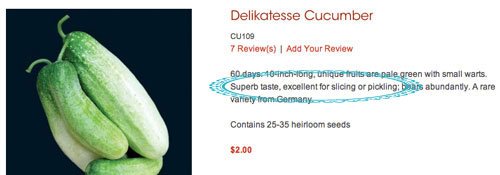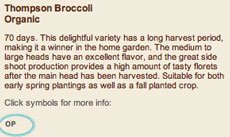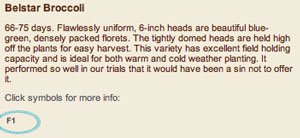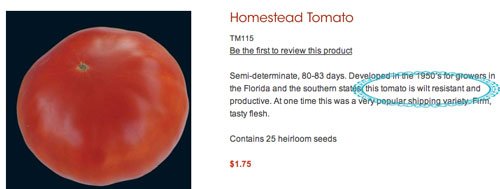Selecting Seeds for Garden Success
Shelves stuffed full of beautiful envelopes that seem about to burst with potential. Page after glossy page of glorious looking, boldly colored vegetables. No wonder it’s so hard to choose seeds for your garden with all the options out there!
Beyond the sheer variety, what about the practical issues like will these tomatoes get blight like the ones I grew last year? How should those mysterious “days to maturity” numbers like 65 or 90 impact my decision making? What on earth does open-pollinated or F1 mean? And how many seeds do I need anyways?
Though its taken me several years of gardening (four to be exact), I feel as though the guessing game of buying seeds has given way to a more purposeful and knowledgeable selection of what will truly perform well in my garden and result in success of the highly edible and delicious variety (otherwise known as food on the table).
As you sift through the options for purchasing garden seeds this year, here are some important things to keep in mind:
Days to Maturity
On the back of most seed packets, and in catalog or online descriptions, you will usually see something like “65 days”. If you’re looking at radishes, the number might be 22 days. If it’s bell peppers it could be as high as 80-95 days.


There is some debate as to how “days of maturity” should actually be defined, but here is a simple working definition that will suit the needs of most gardeners:
- A seedling transplant (like a tomato or pepper plant) should be counted from the days it goes into the ground, so that a 70 day tomato plant should theoretically be ready for harvest just over two months after you transplant it in May or June (so harvest happens in July or August).
- Seeds that are sown directly into the ground (like radishes, lettuce or carrots) should be counted from the day they germinate, so those 22 day radishes planted on April 1st should be ready just right around the end of April.
Why do days to maturity matter? They help you to roughly estimate when a given crop will be ready for harvest, so that you can make your garden plans for successive plantings, to ensure that plants get into the ground early enough in the season and so that you can purchase varieties which will suit your particular climate, growing season and garden needs.
Depending on where you live (North, South, wet, dry, mild summers, etc.) it’s crucial to choose seeds that will suite your growing season. That means that a Northern gardener such as myself should not be using tomatoes with 75+ days to maturity. Why? Because our summers are unpredictable, with temperatures that fluctuate a lot, intermittent days (and weeks) of rain and gray amidst the sunshine, and a generally short growing season. Rather, it would be better for me to plant varieties that primarily take 55-75 days to ensure crops that will be harvestable and fully ripe, with perhaps one large, juicy 80 day variety, just on the off chance that we’ll have a good summer.
Additionally, knowing the days to maturity can allow gardeners to spread out their harvest. Select seeds with a range of days, so that you can have early, mid and late season crops. Succession planting (planting some seeds one week, more the next, and more then next) will also ensure that your harvest comes steadily rather than all at once.

Varieties That Suit Your Needs
How boring it would be if tomatoes could only be grown as medium sized, red orbs for slicing. Thankfully they come in many shapes, sizes and types, such as cherry, plum, slicing, and those that are best for making paste, sauce or for dehydrating.
The same is true for most vegetables. Cucumbers can be long slicers, short slicers, mini gerkins, or various sizes of pickling varieties. Carrots are long and skinny, thick and stout, small and gourmet, even short and stubby for container growing.
Particularly if you care to preserve what you grow, but even for the sheer enjoyment of different types of eating, choose seeds that will offer a variety of tastes and uses according to how you like to consume them. If you want to put away dozens of jars of tomato sauce, you’ll probably want to grow paste tomatoes that are more meaty and less watery. If preserving isn’t a priority, then just a few plants with tasty slicers and one with cherry toms if probably all that you need.
Grow What You Like
Beyond practicality, choosing varieties that just plain taste good is important for your gardening and eating pleasure. Do you like prefer candy sweet cherry tomatoes or ones that have a bit of a tartness to them? Do you love long, thin English styled slicing cucumbers, or the thicker field cucumbers? Will your children be willing to eat that fantastic head of purple cauliflower or should you stick to white for the time being?
There are literally seeds and varieties to suit every taste, every whim. I should know. I drool over seed catalogs and have the hardest time limiting myself to what would be reasonable to actually grow.

Read descriptions carefully. Some sites offer customer reviews (I love the ones at Baker Creek), and these will help you to know whether the seed company’s glowing descriptions pan out in real life. Were they really “intensely flavorful” or just kind of so-so? It’s also helpful to read through other’s gardening journals and to talk to other gardeners that you know so that you can share your favorites with one another.
Open-Pollinated, Heirloom and Hybrid
If you’ve ever been baffled by the letters OP or F1 in a seed catalog, you’re not alone.


The basic gist of it is that open-pollinated seeds are bred through natural growing and pollinating methods, heirloom are open-pollinated and usually at least 50-100 years old, and F1 or hybrids have been bred artificially using genetics and selective breeding for specific plant traits.
Open-pollinated seeds can be saved and used in your garden the following year, but hybrids must be purchase new each year. Hybrids may be more vigorous and have some helpful traits that have been bred into them, although if you look closely into heirlooms you may find that those traits you’re looking for already exist in these seeds that have been passed down through the generations.
Read this post to learn more extensively about the differences between these seeds and why I personally choose open-pollinated heirloom seeds for the most part.
Specific Plant Traits
If you’ve gardened at least one season or more, you’ve probably discovered some of the pests and problems that frequent the area where you live. For me, it’s things like late blight, powdery mildew and cabbage moths. For others it may be potato beetles, squash vine borers or fusarium wilt.
It took me years to discover the glorious fact that some seeds are actually resistant to some of the plights that my garden was facing! Both heirloom and hybrid seeds have been perpetuated or bred because they showed resistance to particular problems. Of course, it’s important to note the word “resistant”. They’ll perform better than other varieties in the same circumstances, but no variety is truly invincible.

I saw the concept of resistance firsthand last year in the fact that my purple Italian cauliflower variety held it’s own against the cabbage moths, but my poor broccoli’s leaves succumbed to a whole lot of nibbling and ended up pretty “holey”. Almost all of my tomatoes ended in late blight disaster when heavy rains struck in September, but one variety withstood the blight better than all the others (Tigerella).
Read carefully through many different varieties to see if you can find seeds that will address the problems that you’re facing. For anyone desiring to keep their garden completely organic, resistant varieties can be a real boon (and when problems still arise, there are always natural methods to deal with them).
How Many Seeds Should I Buy?
The first thing to consider is whether you’re growing a large plant that will produce baskets of produce, or a single vegetables where one seed = one carrot. I’ve had the same seed packets of squash for 3 years (and even shared with friends), because one can only grow so many squash plants in a suburban backyard. Carefully stored, you can get away with infrequent purchases of seeds like squash (including summer squash), tomatoes, peppers, cucumbers and even larger veggies like broccoli, cabbage and cauliflower.
Other seeds are on my “to-buy” list season after season, especially if I plant them twice a year (spring and fall). Carrots, radishes, peas, beets, and lettuce go a whole lot faster. Even in my small garden, I usually go through an entire pack each year, and with crops like carrots and peas I use multiple packs. I make a point of assessing what I have, what I want to grow and how much I need for the coming season before purchasing anything.
Though it’s tempting to buy more, I say buy conservatively because you can always order more later on. Consider the number of seeds per packet and if 200 carrot seeds and 30 tomato seeds sounds pretty reasonable for the scope of your garden, stick with that and save your money. Or go in together with other gardening friends and split up packs to save money while increasing variety.
How do you decide which seeds to buy? Which varieties have turned out to be winners for you and why?
This post is sponsored by My Job Chart, a FREE online, customizable job chart that is revolutionizing the way parents run their homes, and teaches kids to work hard and learn responsibility.
Top image by portmanteus. All other images/seed descriptions from Territorial Seed Company and Baker Creek Heirloom Seeds.
Other Related Posts You May Enjoy
- A Tale of Two Gardens part one and part two
- How to Plan Your Garden part one and part two
- Organization in the Garden: Evaluating What You Have and What You Need
- Getting Organized in the Garden: Seed Starting and Planting Schedule
- Naturally Controlling Pests in the Organic Garden
- 5 Steps to Being a Lazy Gardener
- Gardening in Less-than-Ideal Spaces
- 7 Gardening Lessons from a Novice Gardener
- Gardening with Herbs 101: Where to Begin
- Gardening with Herbs 101: What To Grow
- How to Plant a Garden that Works for Where You Live
- 7 Reasons to Square Foot Garden
- Plan & Plant Now for Sustainability, Freedom, and a Backyard Revolution




I have been very impressed with Baker Creek seeds and really enjoy their beautiful catalogue. We love the Mexican Sour Gherkins–they look like minature water melons and my kids eat them straight off the vine! I also like getting seeds from Sandhill Preservation (they also have heritage chicken breeds) and they offer wonderful customer service! We ordered chicks from them last year and I have the most amazing colored eggs.
I also thought I would add that we give our seeds to a small, family owned greenhouse to start for us for a small cost. In return, we get amazing seedlings that have done exceptionally well in our garden. This way, we get the specific varieties we want without having to recreate a greenhouse in our small basement every year. We live in Michigan, so our plants need a jump start! Have you considered this option?
Thanks for your post! I read this morning that the FDA is getting hit with cuts and gives me ever more reason to grow my own and know my local food sources.
Thanks for this post – very informative. I did not know the “days to germination” ins and outs. Thanks again.
We love Baker Creek Seeds. We had great success with all the seeds we purchased last year (except the onions but it was our fault, nothing to do with the seeds). The rocky mountain lettuce mix is excellent!
@Danielle, Oh, I’m glad to hear you like the Rocky Mountain mix. I just bought it for this year to give it a try!
I love having a garden but my new house doesn’t get enough sun what kind of veggies can I plant thank you